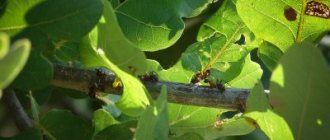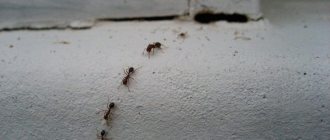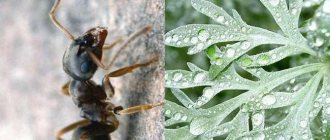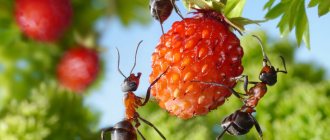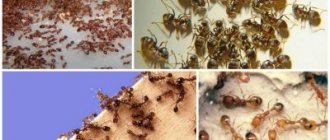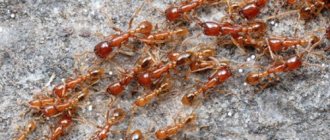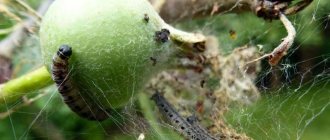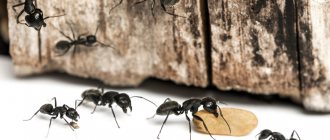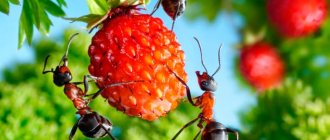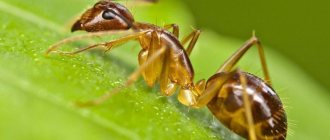The appearance of ants on fruit trees. What benefits do ants bring? What harm do they do to vegetable crops and gardens. Features of pests. Is it possible to completely destroy ants? The use of different methods and methods in the fight against ants.
There are a huge number of species of ants that differ not only in their external characteristics and habitat. For example, there are types of goosebumps that are of great benefit in natural conditions, and there are those that pose a great danger to humans and animals, since they use a sting and potent poison when attacking.
But next we will talk about ants, which are not pests, they are beneficial, but at the same time, they can cause enormous harm to fruit trees, shrubs and other garden crops.
Barrier methods
To protect the harvest of fruit trees, pest control measures must be taken in a timely manner. An effective method is to install barriers at ground level. You can do this in several ways:
- Using a car tire. Cut it in half, dig a ditch under the tree and place part of the tire there, digging it well and fixing it with earth. Pour water inside: ants cannot swim, so the tree will be reliably protected.
- Through chalk. To get rid of ants on a personal plot and protect fruit trees, crushed chalk is scattered on the ground at the roots, and the trunks are rubbed with this powder. White particles stick to the paws of insects, impairing grip, so the pests simply fall from the tree and cannot reach the branches with young shoots.
- Using foil. To prevent pests from climbing trees, a kind of “skirt” of foil is formed around the trunk. It is difficult for insects to crawl on a slippery surface, so they fall to the ground.
Benefits and harms
So, speaking about the benefits they bring, it is worth noting that goosebumps eat pests, are of little interest to garden plants, and they also take a direct part in soil aeration. Now let's look at the main points of harm. When colonies grow, they are able to eat anything that is edible. They promote the reproduction of aphids, since it is their source of sugar necessary for life. Damage the root system of plants.
As you can see, the harm caused covers up all the good that these insects can bring, so the fight against them should be carried out without fail. It is also worth knowing about one more point: red goosebumps are poisonous insects that can destroy poultry eggs and even kill a chicken.
In fact, ants are not at all kind insects and can hardly be called friendly and peaceful. They occupy the top positions in the food chain, and all for the reason that there are practically no natural enemies in nature.
They can safely be classified as polyphagous predators, since they easily eat all living things that come their way. One feature that prevents them from being classified as omnivorous insects is that their body is not able to digest cellulose, which is both a positive and a negative point for people.
As already mentioned, they have no natural enemies, but at the sight of a ladybug, panic begins in the colony. All for the reason that these bugs, just like goosebumps, love aphids, in this case it is absolutely useless to use their poison, since it has no effect on ladybugs. The only way to eliminate the threat is to throw the ladybug off the branch; to do this, they gather in a flock and attack the bug.
When there are a large number of individuals in a colony, a lot of food is also required, which means that they will get it wherever they can. First of all, seedlings, young plants, root systems and, of course, the juicy fruits of trees that contain sucrose, cherries, pears, apples, etc. are affected. We must remember the harm that aphids cause, and goosebumps do everything to make them multiply.
Hunting belts
This method of eliminating pests involves tying tree trunks with special belts. Their width varies for each method, the average is 20 cm. Options for creating fishing belts:
- the clothesline is generously treated with Vaseline and wrapped around the trunk at a level of 20 cm above the ground (Vaseline interferes with the movement of insects and is absolutely harmless to plants);
- trunks in the garden are covered with film and coated with grease, resin or birch tar;
- double-sided tape or adhesive tape will help protect garden crops; aphids, ants and other pests stick to the base;
- To combat ants, they also use cotton wool soaked in a carbolic solution: they tie it around the trunk for 3 days, after which the bandage is changed (three such procedures are enough throughout the summer).
Safe chemistry in the garden
Today the word chemistry is treated with caution. But not all means are dangerous. In the garden, you can use time-tested methods that do not harm not only humans, but also plants. So, an indispensable assistant for a gardener is lime. It is used to whiten trunks, and you can also add it to the tree trunk circle. It is poisonous to ants. And although the colony will not die from such a remedy, insects will avoid the treated area. No less popular and useful in the garden is boric acid. It is used for cosmetic and medical purposes. This is an excellent antiseptic. But for insects it is a strong poison that acts both superficially and through the intestines. In the garden, it can simply be added to the soil in powder form. If you need to get rid of an anthill, then remove a layer of soil from it and pour poison directly into the center of the nest.
Prices for chemicals against ants
| Name | Weight | Volume | Price |
| Exil powder (for garden ants) | 100 g | — | 203 RUR |
| Spray Dr.Klaus Insect | 1 kg | 750 ml | 374 RUR |
| Get Express tool | 100 g | — | 870 rub. |
| Medilis-SUPER | 50 g | 50 ml | 265 RUR |
| Gel MaxForce (from ants and cockroaches) | 20 g | — | 799 RUR |
| Aerosol Dr Klaus | 1 kg | 600 ml | 259 RUR |
| Spray Argus Garden (for garden ants) | — | 250 ml | 122 rub. |
| Deadly drops No. 1 from ants | 2.5 g | — | 131 RUR |
| Dobrokhim-FOS | 1 kg | — | 2270 RUR |
| Gel Alcot (from ants and cockroaches) | 30 g | — | 123 RUR |
| Medilis-CIPER | 510 g | 500 ml | 1534 RUR |
| Ecokiller (for garden ants) | 200 g | 500 ml | 349 RUR |
Ants often settle on young trees. Boric acid will also tell you how to get rid of them. It is diluted in warm water. The solution is sprayed on the tree. It affects not only ants, but also aphids. Moreover, it is completely safe not only for the plant, but also for people. The harvest from sprayed trees can be eaten even on the day of treatment.
This is how you can use borax. It is no less toxic to insects than boric acid and their effect is similar. It is added to baits. In stores you can buy granular Anti-Ant preparation, which contains 10% borax. The granules can be left in blisters in places where insects are located or poured into the anthill itself.
Many gardeners and gardeners recommend using an insecticide of biological origin: Pyrethrum. These are crushed Dalmatian chamomile flowers. It is poisonous to ants and other insect pests. This remedy has also been known for centuries under the name Persian powder.
To protect plants in the garden, you can dilute the drug in water and use it for spraying. The product is completely safe for people and animals, even if swallowed. The powder decomposes quickly and does not affect the eggs and larvae of insects, so to obtain a positive result you will need several treatments with a break of two weeks. This product is less effective than modern pesticides, but it is great for households that try not to use chemicals.
Processing of trunks
Professional preparations for insect pests provide a quick effect, but folk remedies are more environmentally friendly and harmless to fruit crops. Processing of trunks can be carried out in the following traditional ways:
- A thick mixture of table salt, soot, and linseed oil is applied to the bark in a dense layer of 15 cm (all components are taken in equal quantities);
- the trunks are coated with low concentration bleach, since excessive amounts harm the plants;
- Garlic repels ants, so the bark can be rubbed with cloves to ensure a lasting odor.
How to get rid of ants on your property once and for all
Ants that have settled in a garden or vegetable garden are more enemies than friends for the owner of the property.
On the one hand, these hardworking insects command respect due to their organization, cohesion and discipline. They build anthills by making passages in the ground or making an embankment, and can also settle in the wall of a building. However, when an anthill appears in a garden, in a garden bed or in a flower bed, a large invasion of insects annoys a person. In addition, ants breed aphids; for them, these small insect pests are like cash cows; the ants feed on the sweet secretions of aphids and specifically spread these pests to plants for reproduction. To remove aphids, you will first have to get rid of the ants in the area.
It’s a fact, but aphids without ants do not spread throughout the garden so quickly and die under unfavorable conditions . Aphids settle in the garden on apple, pear, cherry, currant and other plants. Small pests prefer to live on young leaves and shoots, sucking out their juice, causing the leaves to curl and the shoots to stop growing. The aphids multiply quickly, and the ants disperse the larvae into new plants that have not been colonized by aphids. Ants, as true hosts, protect aphids from other insects and keep several individuals in the anthill in winter for reproduction the next season. When severely infested with aphids, garden trees and shrubs do not grow and do not produce crops.
When treating plants with various aphids, it is also necessary to take measures to evict the ants from the site. Having eradicated aphids from trees and shrubs, the ants will soon colonize new colonies of pests on them.
Ants independently choose a place to settle and can build an anthill in a flowerbed, garden bed, greenhouse, garden, in the wall of a building, at the roots of garden trees and shrubs, or under a garden path, from where it is difficult to expel unwanted guests. As the ants multiply, they will enlarge the anthill, making more passages deeper or increasing the earthen mounds. If you do not immediately drive the ants out of the area, their number will increase and over time it will be more difficult to get rid of the ant nest.
Garden ants require sweet carbohydrates and proteins for nutrition. Ants get sweets not only from the secretions of aphids; they can eat strawberries, raspberries, and also love sugary vegetables and root vegetables - carrots, beets, pumpkin. In flower beds, insects feast on delicate flower buds; ants can often be seen on peony or rose buds.
To get proteins for their diet, ants destroy many insect pests - various caterpillars, moths, cutworms, bark beetles and sawflies.
Ants create a huge family; in their society, each individual has its own role. One anthill can live from several thousand to a million ants. Adults are divided by profession - these are soldiers, builders, porters, scouts, nannies. Ants reproduce with the help of females and males; during the mating period they have wings and fly up to mate. After fertilization, the female sheds her wings and the males die.
A female ant or queen can live up to 20 years, an incredible age for insects, during which time she can give birth to more than 100 million worker ants and up to tens of thousands of new females and males. There may be not one female in an anthill, but several. The queen is not the main one in the anthill; it is the worker ants who select the most fertile females, settle them in the passages, feed them, and also leave the required number of larvae for each profession.
Folk ways to remove ants from a site:
You can get rid of ants in your garden using simple folk remedies without using dangerous drugs.
Many people probably tried to destroy the anthill or poison these insects, but these hard workers restore their home in a matter of days, and it is simply impossible to destroy an army of thousands of ants. You can get rid of ants in your area by scaring them off with various smells so that they move to a new place or walk around protected plants. Ants do not like the strong odors of many plants - garlic, tomato tops, mint, anise, tansy, wormwood. To scare away ants, place sprigs of fragrant greenery around the anthill and plants for protection.
Some people drive out ants using odorous herring heads, lemon, cloves, mustard powder or ground black pepper. However, these products do not guarantee that the ants will leave and not return, since the smell of herbs and other products will disappear over time.
The main way to evict ants from a site is to dig up an anthill and move it to a forest or other remote place. You can dig an anthill if it is not located in the roots of trees or shrubs, next to plants, under a path or in a wall. You need to dig tunnels deep to the lower levels where the ants place their eggs and larvae. Pour the anthill into a bucket, greasing its top with vegetable oil, or into a bag so that the insects do not crawl out. You need to dig out the anthill in the evening, when all the workers have returned home.
You can remove ants from dug holes under tiles of garden paths or in small cracks in walls and in greenhouses by covering the exits from the anthill with salt or soda on top. The insects will not be able to remove the fine powder away from their home and will go off to look for a new home.
Wood ash also effectively repels ants and is an excellent fertilizer. To protect plants from ants and other pests, place a palm-wide layer of ash around the plants or beds in a ring; ants will not pass through such a barrier.
If you regularly fill the anthill with a hose so that all the passages are filled and the ants do not have time to dry them, sooner or later they will leave the unfavorable place, but they may move nearby.
Ways to get rid of ants forever:
A simple folk method to get rid of ants on your property using yeast is effective. Take a piece or a tablespoon of dry yeast, mix it with a little water and a spoon of sugar. Pour the yeast into small cups or jars and, covering it from the sun and rain, place it around the anthill; the ants will disappear in a couple of days.
Those who do not feel sorry for numerous insects can try to remove an anthill with boiling water . It is better to fill the anthills with boiling water in the spring so that the hot water fills the lower passages and the eggs and larvae of the new generation of ants are cooked in them. By carrying out this operation monthly, you will curb the massive reproduction of ants.
You can reduce the number of ants and completely destroy them using poisonous baits . Ants love to eat sweets, prepare sweet syrup, jam or melt honey by adding a little yeast (20 g) and boric acid (5 g) per half liter. You can mix sweets with other chemicals, the ants will eat them and feed the larvae, and in a couple of days they will die.
For spraying
Trees are treated against pests several times during the spring-summer season. For this purpose, different spraying methods are used, including the following:
- A solution of soap and kerosene. Add 2 tbsp to 10 liters of water. l. carbolic acid, 100 ml of kerosene and 0.4 kg of black soap (charcoal based). This mixture is used to water anthills and spray fruit crops.
- Soda solution. This remedy is equally effective against both ants and aphids. In a liter of water you need to dilute 30 g of linseed oil and 5 g of soda. Plants are sprayed several times over a short period of time, and then if necessary.
- Coca-Cola for spraying. The sweet drink is diluted with water 5:1, after which the mixture is used to treat fruit trees. One good spray is enough to get rid of ants.
- What are the most effective lozenges for a sore throat?
- Cystitis - treatment at home with folk remedies and medicines
- How to get rid of mold on walls using folk remedies. Getting rid of black mold forever, photo
Protecting fruit trees from aphid pests
One of the most harmful plant pests is aphids. This tiny insect forms colonies that are voracious. The spread of aphids can destroy the crop and even destroy the plant, so the fight against harmful insects must begin immediately.
Aphids appear on fruit trees thanks to ants, for which the waste products of small insects are a source of food. When using methods for killing aphids, it is important to take care to simultaneously use proven products against ants.
Professional products
If traditional methods do not help, you can get rid of ants using special chemicals. The following preparations are used to treat fruit crops:
- A great warrior. The trunks are treated with the gel in short strokes at intervals of 2–6 cm. The drug retains its properties for 20–30 days. The product attracts ants with a sweet aroma (not perceptible to humans); the insects eat part of the poison immediately, and take the other part to a nest on the body. There, the gel is eaten by those individuals that do not leave the anthill. As a result, the pest colony dies within 2–3 days. The Great Warrior is produced in a convenient 30 ml syringe and costs about 40–45 rubles.
- Clean house. The gel has a similar effect and is available in the same syringe as the Great Warrior, but has a slightly larger volume - 35 ml. The poisonous substance remains in one place for two months. It is better not to lubricate the plant itself with the product, but to use pieces of cardboard treated with poison that are tied to the tree. The cost of the drug is 50 rubles.
- Ant-eater. The drug is sold in containers of 10 and 50 ml, in addition, disposable ampoules of 1 ml are also available. The cost of the Anteater is relatively low; for example, a 50 ml bottle costs 155–170 rubles, despite the fact that for 5 sq. m area, only 1 ml of product is needed (it is diluted in 10 liters of water). To get rid of insects, you first need to slightly dig up the anthill, then the larvae will appear on top (they are white and look like grains of rice). Afterwards, the poison is evenly poured into the ants' house. The drug continues to work for another 3 hours after use, so it affects all individuals, including those that will return to the anthill during this time. The chemical does not accumulate in the soil and does not harm pets or birds. However, the Anteater is dangerous for fish, so it should not be used near bodies of water. It is allowed to use the product for spraying potatoes, strawberries, and other shrubs that are in the growth stage, but the product cannot be used to treat the roots or seeds of plants.
Reasons for appearance
Before resorting to any methods of dealing with goosebumps, it will be useful to learn about them some features of their behavior and life activity, then it will be much easier to cope with them. It’s worth saying right away that these insects are quite smart, organized, hardworking, and each individual is part of a huge, well-established mechanism.
Each anthill is a colony of individuals that are divided into groups. Each group does a specific job. The main one is the uterus, which is served by working individuals, they also care for the future offspring, feed and protect them, since the uterus only lays eggs.
Depending on the species, colonies may have their own differences. The very first difference is the number of individuals, there are anthills in which there are more than a million ants. When the queen dies, the colony disintegrates, and often all the workers also die. But the red goosebumps in the colony have not one queen, but several, for this reason it is much more difficult to fight this species.
The main reason why they settle in vegetable gardens and orchards is to search for food. Often the search for a new habitat occurs in the spring. There are several reasons that increase the risk of these insects appearing in areas. The reason may be plant debris from last year, where they overwintered and are now ready to move into new territories.
Also common causes include natural fertilizers, manure heaps in which goosebumps are present. Scouts are the first to explore a new territory; if everything suits them, they bring the entire colony. Finding them on the site is not always easy, since they may not build an anthill, but live under the bark of trees, in hollows or roots.
Use of plants
You can get rid of ants in a simple way - by scattering certain herbs on the area, the smell of which insects cannot stand. Bunches can also be hung from trees or used to make rich infusions and sprinkled over the garden. Insects do not like the following types of plants:
- mint;
- sagebrush;
- calendula;
- chamomile;
- tansy;
- elder.
To avoid the pest returning to the garden, it is important to carry out spraying procedures systematically. In addition, in order to get rid of ants for a long time, it is necessary to periodically replace scattered and hanging herbs with fresh ones.
Varieties
If we talk about species that are capable of settling in gardens and vegetable gardens, then here you can only find black and red goosebumps.
Redheads
It is worth saying that this species likes to settle closer to people, in other words, they are of little interest to just a garden. They prefer to be adjacent to living quarters, but at the same time they love to eat juicy, sweet fruits. To set up a colony, they choose the voids under houses, crawling through the cracks.
As already mentioned, colonies have not one queen, but several. Their nests are arranged in a rather unique way; there are several of them, each with its own queen, and they are connected to each other by special passages. If we take into account that the queen lives for about 15 years, then we hope that the colony will disintegrate and disappear.
Garden black
Despite the name, individuals of this species may differ in the color of their body. It depends on the habitat and the soil. They can be gray, black, yellow, brown. All of them perfectly adapt to new conditions, can live in absolutely any soil, and are not afraid of climate change and temperature changes.
Colonies grow quickly and, in addition to the fact that anthills are located in gardens and vegetable gardens, they can settle in residential premises. Their nests can be located in the soil, under the house, in the house, under stones, in rotten wood, in tree hollows.
Prevention
In order to avoid the need to take drastic measures to exterminate ants on your site, you need to regularly do the following:
- Look through plant leaves and destroy aphids if found. To do this, just spray the leaves with a special product.
- Regularly dig up the soil to a depth of at least 10 cm.
- Pruning old and diseased tree branches of plants.
- Do not leave boards or pieces of paper on the site; regularly look under stones to check for the possible presence of ants.
- You can plant fragrant plants around the perimeter of your summer cottage. It could be lavender or garlic.
- Ants can destroy a pear or other fruit tree by settling in a hollow or crack in the trunk. It is necessary to inspect such places.
These and other similar preventive measures will significantly reduce the likelihood of ants appearing on the site.
When killing ants, the most important thing is to find the place where the anthill is located. Sometimes it can be determined by monitoring the activity of ants. This will help you get rid of them for a long time. However, it is better to carefully monitor the condition of the area and, at the first alarm, take the necessary measures to clear the ants.
Ants on a pear - what to do?
Chemicals
Granular preparations Barguzin, Grom, Medvetoks, Muraviin are effective, acting on insects as an intestinal poison. If the anthill is located in close proximity to the tree and has already reached a large size, it is better to add these preparations in the fall - this way they will have time to inactivate and will not be absorbed by the root system or get to the pear fruits. The soil should be treated with granules in the doses specified in the instructions.
When the leaves bloom, the pear can be sprayed with Decis, Inta-Vir, Iskra.
Gels have proven themselves well, for example, Great Warrior, Raptor, Fas, Sturm. The gel is squeezed out under a tree, as close as possible to the anthill. Its smell attracts ants, and they carry it on their paws throughout the colony. The substance is toxic, most of the active substances destroy the chitinous cover of insects and after a few days they die.
Attention! Contact insecticides are toxic to humans; they kill worker ants (including red ones), but rarely affect the queen - there is a possibility that after some time the anthill will reappear in its original place. To kill the queen, workers must spread the gel on their paws throughout the entire home, including deep inside the nest.
Aerosols and sprays often only kill a small portion of the population, but never affect the queen.
In the spring, you can spray pears with a 3% solution of Bordeaux mixture or iron sulfate - this procedure serves to prevent fungal diseases and aphids. Treatment should be carried out in dry, windless weather.
Colony of ants and aphids
To repel ants, you need to deprive them of their natural food - aphids. To do this, the pear is treated three times a year with one of the drugs: Fitoverm, Iskra, Agrovertin, Fufanon. With the exception of Fitoverm, these products are quite toxic, so they are not recommended for use in the summer, when the tree is bearing fruit.
Biological agents
These remedies are somewhat less effective than chemical ones - garden ants quickly develop immunity. But a group of these substances can be used during fruit ripening - they are not toxic to humans. Almost all of the products in this group are aimed at combating aphids, an intermediary in the infestation of trees by ants.
One of the proven remedies is a tobacco soap solution (soap is used to make the substance sticky and stay on the plant longer). But it will be difficult to spray or coat a large, heavily damaged tree with it; it is more advisable to apply it to dwarf pears or small colonies of insects. An infusion of pine concentrate has the same effect - it is prepared at the rate of 35 g of pine needles per 10 liters of water.
Preparation of tobacco soap solution
Tansy, calendula, marigolds, onions and garlic repel pests - these plants can be planted near the pear to save the tree. Another way is to rub the tree trunk with a decoction of garlic or wormwood. The disadvantage of this method is that the insects will leave the pear, but will find another place on the site for a home.
Mechanical wood protection
One of the ways to fight ants less bloodily is to scare them away. Mechanical means are a variety of traps and catching belts that are attached to the tree trunk and prevent climbing along it, protecting the shoots and fruits of the pear.
Garden stores sell special protective adhesive belts (for example, Aeroxon). They are wrapped around a tree in early spring, around the end of March, when the snow has almost melted and sufficiently exposed the trunks. The belt is attached at a height of 60-80 cm; it helps fight not only ants, but also codling moths and other pests.
Advice!
Honey or sugar solution is used as a trap: a bottle or washcloth with it is placed on the ant path. Once filled, place it in boiling water or do something more humane - throw it away.
For protection, you can use foil belts. It is necessary to wrap the foil around the trunk at a height of approximately 80-100 cm from the ground so that the edge of the foil is inclined and sharp - insects cannot overcome it
It is important that the foil fits tightly to the bark and the ants cannot crawl under it. In the same way, you can make a belt from a small metal plate: fasten it to a tree trunk in the shape of a funnel (cone), coating the junction of the funnel with the tree with plasticine so that the ants cannot overcome the barrier.
Options for catching belts
The tree trunk circle can be sprinkled with quicklime or soda and dug up - this should also scare away uninvited guests.
Another way is to coat the tree trunk with a mixture of ash and clay - the ash repels insects.
Important! Mechanical means scare away the tree, but do not destroy the colony. Therefore, if ants have settled in the roots of a pear, you need to use granules or gels, otherwise it will be difficult to save the roots of the tree
general information
Ants are widespread throughout almost the entire planet.
Currently, more than nine thousand species are known. However, in central Russia, only three of their varieties are most common:
- These ants are called Red Myrmica . Their length is 4-5 mm. The color of insects can range from red-brown to yellow. They prefer to eat various small arthropods. They are actively involved in breeding and eating aphids. They eat both living and dead insects.
- The forest red ant is characterized by medium size. Its color is black and red. Listed in the Red Book of Endangered Species.
- The black garden ant is one that mainly lives in gardens and vegetable gardens. This includes earth ants, which are relatively small in size. Their average length is 3 mm. The uterus is almost twice as large. Their length can reach 10 mm. It feeds on live and dead insects and actively breeds and eats aphids. This is their main food. Besides this, they also eat other foods.
The latter variety of ants is the subject of this article. They are of particular interest due to the fact that the life of each anthill can be characterized as social.
Black garden ant
In addition, there is a common belief that these insects are beneficial: “they work tirelessly” and the like. In fact, they, like other living beings, do what is useful to them. At the same time, they affect raspberries, cucumbers, currants, and other plants in the garden, vegetable garden or greenhouse, often causing them harm.
However, in some cases the activity of these insects has some beneficial aspects.
Consolidate the result
Smells that repel ants After carrying out active measures, a reliable rear should be provided so that a new colony of ants cannot settle after a while.
It is necessary to seal all the cracks in the wall, the gaps between logs, in window sills, under baseboards. Do everything to prevent small insects from entering the house.
Since it is difficult to ensure complete isolation of the room, repellent substances should be used. It is better to expel uninvited guests using folk remedies.
- Place chopped garlic or whole cloves around the perimeter of the house, on window sills, behind furniture. Rub the arrows of winter garlic on the walls.
- Scatter cinnamon indoors. Suitable ground or in sticks. In the latter case, the smell lasts longer.
- Plants are laid out in the house - chamomile, peppermint, bouquets of wormwood, tansy, elderberry. In the absence of plants, you can use essential oils. They drop it into the water, rub it on the floor, walls, and leave it on a plate.
- Carry out general cleaning of the house using a vinegar solution. Ammonia has a similar effect.
If ants appear in a wooden house, it is necessary to identify the anthill, carry out disinfestation, and provide prevention
Since insects enter the house from the outside, attention should be paid to the garden area. Plant mint and calendula around the perimeter of the house, create beds with garlic
